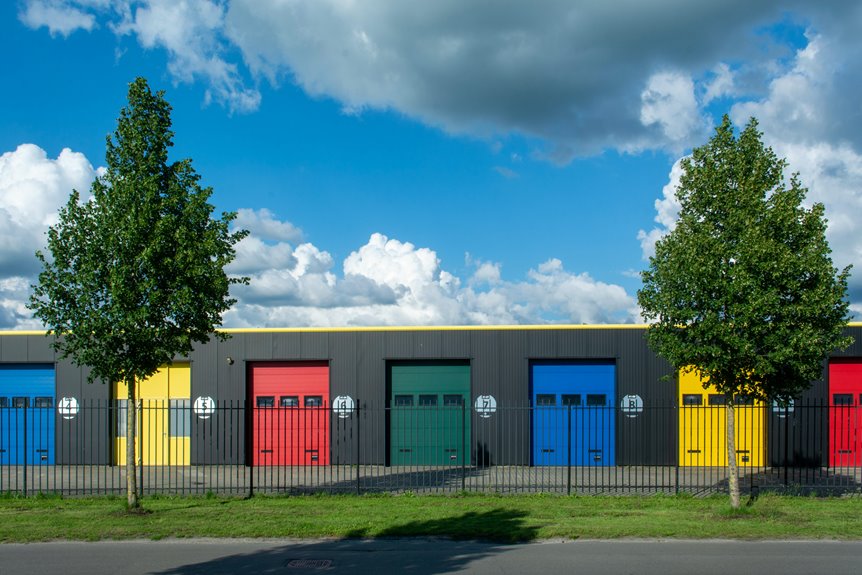In my recent analysis, I came across a compelling scenario where a commercial property investor and a residential property investor faced contrasting challenges due to the unique nature of their investments.
The intricate differences between commercial and residential properties go beyond mere physical structures; they encompass a diverse array of factors that dictate investment success in each domain. Understanding these nuances is vital for making informed decisions in the real estate sector, where the stakes are high and the outcomes can greatly impact financial portfolios.
Key Takeaways
- Commercial properties offer higher income potential due to higher rental rates.
- Residential properties cater to individuals and families for housing purposes.
- Commercial leases are longer, providing stability for both landlords and tenants.
- Commercial loans have higher down payment requirements and shorter terms.
- Commercial properties are subject to zoning laws and environmental regulations.
Property Usage
When it comes to property usage, commercial properties are primarily used for business purposes, while residential properties are used for housing.
Commercial properties include office buildings, retail spaces, warehouses, and industrial buildings. These spaces are leased or rented to businesses and generate income through rent payments. Businesses operate in commercial properties to sell products or offer services, making these spaces essential for economic activities.
On the other hand, residential properties consist of houses, apartments, condos, and townhouses where individuals and families live. These properties provide a place for people to reside, relax, and enjoy their personal lives. Residential properties aren’t intended for conducting business activities, but rather for providing a comfortable and safe environment for inhabitants.
Understanding the distinct purposes of commercial and residential properties is vital for investors, developers, and individuals looking to either establish a business or find a place to call home.
Ready to invest in commercial real estate? Understanding the different types of commercial properties is key to making informed decisions. If you’re looking to sell your commercial property, Cash4Houses can help you navigate the process with ease. We offer fast, fair cash offers that let you move forward confidently. Get your cash offer today and take the next step in your real estate journey!
Investment Potential
In evaluating investment potential, commercial properties generally offer higher income potential compared to residential properties. Commercial properties, such as office buildings, retail spaces, and industrial warehouses, tend to generate higher rental income due to longer lease terms and typically higher rental rates.
With commercial properties, there’s also the potential to earn additional income through various means like triple net leases, where tenants pay for property expenses, or revenue-sharing agreements.
Moreover, commercial properties often attract more stable and established tenants, such as reputable businesses or corporations, which can lead to consistent cash flow and lower vacancy rates. On the other hand, residential properties, while offering the potential for rental income, may face challenges such as frequent turnover, rent collection issues, and property maintenance costs.
Investing in commercial properties can provide investors with the opportunity for higher returns, diversification, and potential appreciation over time. However, it’s essential to conduct thorough market research and due diligence before venturing into commercial real estate investment to mitigate risks and maximize potential returns.
Tenant Considerations
Tenant demographics play an essential role in determining the success of a commercial property investment. Understanding the needs and preferences of potential tenants is vital in attracting and retaining them. Commercial properties often cater to businesses, so factors like location, visibility, and accessibility are key considerations for tenants. Businesses may also require specific amenities or infrastructure, such as parking spaces, loading docks, or office layouts tailored to their operations.
| Tenant Considerations | Commercial Property | Residential Property |
|---|---|---|
| Location | Proximity to business districts, transportation hubs | Proximity to schools, shopping centers |
| Space Requirements | Offices, warehouses, retail space | Bedrooms, bathrooms, living areas |
| Amenities | Parking lots, security systems, elevators | Swimming pools, gyms, recreational areas |
| Lease Terms | Longer leases, customized terms for business needs | Standard lease agreements, shorter lease terms for flexibility |
| Maintenance Responsibility | Shared responsibility between landlord and tenant | Typically landlord’s responsibility, except for tenant-caused damages |
Lease Lengths
When comparing lease lengths between commercial and residential properties, it’s important to take into account the duration of the leases. This aspect not only affects the landlord’s income stability but also impacts the tenant’s ability to plan for the long term.
Understanding the tenant rights and obligations associated with lease lengths is vital for both parties involved in the rental agreement.
Lease Duration Comparison
Typically, commercial property leases tend to have longer durations compared to residential property leases. In the commercial real estate sector, lease durations commonly range from five to ten years, sometimes even longer for large corporate tenants. This extended lease length provides stability for both landlords and tenants, allowing businesses to establish themselves firmly in a location and landlords to secure steady rental income over a more extended period.
On the other hand, residential leases typically have shorter durations, commonly lasting for one year. This shorter lease term offers tenants more flexibility to move if needed and provides landlords with the opportunity to adjust rental rates more frequently based on market conditions. Residential tenants often prefer shorter leases as they’ve the option to relocate more easily, while landlords appreciate the ability to reassess rental rates regularly.
In essence, the difference in lease durations between commercial and residential properties reflects the distinct needs and priorities of businesses versus individuals in the real estate market.
Tenant Rights and Obligations
In commercial property leases, the lease length greatly impacts both the rights and obligations of the tenant. The duration of a commercial lease can vary greatly from residential leases, often spanning several years.
Longer lease lengths in commercial properties provide tenants with more stability and predictability regarding occupancy. As a tenant in a commercial property with a longer lease, I’ve the right to exclusive use of the space for the agreed-upon period. This means I can conduct business without the fear of being asked to vacate the premises abruptly. However, with this right comes the obligation to fulfill the terms of the lease for the entire duration, including paying rent on time and maintaining the property as per the agreement.
Shorter lease lengths, on the other hand, may offer more flexibility but can also result in more frequent negotiations and potential disruptions to my business operations.
Maintenance Responsibilities
Property maintenance responsibilities vary greatly between commercial and residential properties. In my experience, as a property owner, I’ve noticed distinct differences in how maintenance tasks are handled.
In commercial properties, tenants typically have more extensive maintenance obligations. They’re often responsible for repairs, maintenance, and sometimes even structural improvements. Commercial leases commonly outline these responsibilities in detail, making tenants accountable for keeping the property in good condition.
On the other hand, residential properties usually place the burden of maintenance on the landlord. As a landlord of residential properties, I find myself responsible for ensuring that the property meets certain standards of habitability. This includes handling repairs, addressing maintenance issues, and ensuring the overall well-being of the property. Residential leases often require landlords to maintain the property in a safe and livable condition, shifting the maintenance responsibilities away from the tenants.
Understanding these differences in maintenance responsibilities is essential for property owners to effectively manage their properties and uphold their obligations to tenants.
Financing Options
When considering financing options for commercial and residential properties, it’s important to compare loan terms, understand interest rate variations, and be aware of the differing down payment requirements.
Loan terms can greatly impact the overall cost and feasibility of a property purchase, while interest rate variations play a key role in determining the long-term financial commitment.
Additionally, the amount required for a down payment can vary greatly between commercial and residential properties, affecting the initial investment needed.
Loan Terms Comparison
When comparing loan terms for commercial and residential properties, it becomes evident that financing options can vary greatly. In my experience, one key difference lies in the loan-to-value ratios. Commercial property loans typically have lower LTV ratios compared to residential properties. This means that for commercial properties, lenders often require a larger down payment, sometimes as high as 30% or more, while residential property loans can have lower down payment requirements, sometimes as low as 3% for certain government-backed mortgages.
Another important distinction is the loan term length. Commercial property loans usually have shorter loan terms, often ranging from 5 to 20 years, with a balloon payment at the end. In contrast, residential property loans commonly have longer terms, typically 30 years for a fixed-rate mortgage. This disparity in loan terms can impact cash flow and overall investment strategies for commercial versus residential properties.
Understanding these differences is essential when deciding between investing in commercial or residential real estate.
Interest Rate Variations
I’ve noticed that interest rates for commercial property loans tend to be higher than those for residential property loans. This difference in interest rates is primarily due to the higher risk associated with commercial properties compared to residential properties. Lenders consider commercial properties riskier investments, leading to increased interest rates to compensate for this risk. On the other hand, residential properties are seen as more stable and less likely to face significant market fluctuations, resulting in lower interest rates for loans.
| Loan Type | Average Interest Rate | Loan Term |
|---|---|---|
| Commercial | 5.5% | 20 years |
| Residential | 3.5% | 30 years |
| Down Payment | 25% | 20% |
Down Payment Requirements
Moving on to discussing the down payment requirements for commercial and residential properties, financing options play a significant role in determining the initial investment needed for each type of property purchase.
When it comes to residential properties, down payment requirements are generally lower compared to commercial properties. Residential property purchases typically require a down payment ranging from 3% to 20% of the property’s purchase price, depending on the type of mortgage and the borrower’s creditworthiness.
On the other hand, commercial property purchases usually necessitate a higher down payment percentage. Commercial real estate loans often require a down payment of 20% to 30% or more. This higher down payment is due to the increased risk associated with commercial properties and the larger loan amounts involved.
Lenders typically view commercial properties as higher risk investments compared to residential properties, hence the need for a more substantial down payment to mitigate this risk. Understanding these differences in down payment requirements is essential for investors looking to venture into either commercial or residential real estate.
Market Trends
In the real estate industry, market trends play a pivotal role in determining the performance of both commercial and residential properties. Understanding these trends is essential for investors, developers, and buyers to make informed decisions. Here are some key differences in market trends between commercial and residential properties:
| Market Trends | Commercial Property | Residential Property |
|---|---|---|
| Demand | Influenced by economic factors and industry growth | Affected by population changes and consumer preferences |
| Pricing Dynamics | Valued based on income potential and lease agreements | Driven by location, school districts, and home size |
| Market Volatility | Less susceptible to rapid fluctuations | More sensitive to economic downturns and interest rates |
| Investment Strategy | Focus on long-term leases and ROI | Often emotional purchases with potential for appreciation |
Analyzing these aspects can provide valuable insights into the distinct behaviors of commercial and residential real estate markets.
Regulatory Framework
Within the real estate industry, the regulatory framework greatly impacts the operations and compliance requirements for both commercial and residential properties. As a property owner or investor, understanding and adhering to these regulations is vital to avoid potential legal issues and guarantee smooth operations.
Commercial properties are subject to a different set of regulations compared to residential properties. Zoning laws, building codes, and environmental regulations play a significant role in commercial real estate. For instance, commercial properties may have specific zoning restrictions that dictate the type of businesses that can operate in a particular area. Building codes for commercial properties are often more stringent due to safety concerns and the larger scale of commercial structures.
On the other hand, residential properties are governed by regulations that focus more on the rights and responsibilities of landlords and tenants, such as lease agreements, eviction procedures, and fair housing laws. Compliance with these regulations is essential to maintain a positive landlord-tenant relationship and provide legal protection for both parties.
Understanding the regulatory framework for both commercial and residential properties is essential for successfully maneuvering the real estate market.
Conclusion
In the world of real estate, commercial properties are like a sturdy oak tree, providing steady income and long-term stability. On the other hand, residential properties are like a blooming garden, with varying seasons and changing landscapes.
Understanding the key differences between these two property types is essential for investors and business owners to make informed decisions and cultivate a successful portfolio.
Choose wisely, and watch your investments grow like a well-tended garden.
Curious about your commercial property options? Whether you own a retail space, office building, or industrial property, knowing the types can help you maximize your investment. If you’re considering selling, Cash4Houses provides quick and hassle-free cash offers. Contact us now for your cash offer and start your selling process today!
Frequently Asked Questions
Can Residential Properties Be Used for Commercial Purposes?
Yes, residential properties can sometimes be used for commercial purposes, but this may be subject to zoning laws and regulations. Prior to converting a residential property for commercial use, it is important to consult with local authorities and secure required permits.
Are There Restrictions on the Types of Businesses in Commercial Properties?
Yes, there are restrictions on the types of businesses in commercial properties. Zoning laws and property-specific regulations determine what types of businesses can operate in a commercial space, ensuring they align with local guidelines.
How Does the Tenant Turnover Differ Between Commercial and Residential Properties?
When it comes to tenant turnover, commercial properties generally experience longer leases and fewer turnovers compared to residential properties. This stability can be advantageous for landlords seeking consistent income and reduced vacancy rates.
What Are the Typical Maintenance Costs for Commercial Properties?
Maintaining commercial properties typically involves higher costs due to specialized systems and larger spaces. Regular upkeep, repairs, and compliance with codes are essential. Budgeting for these expenses is vital for the property’s success.
Are There Specific Tax Implications for Owning Commercial Properties Versus Residential Properties?
When it comes to tax implications, owning commercial properties may have different rules than residential ones. Consulting with a tax professional is crucial to understand the specific tax implications for each property type.











